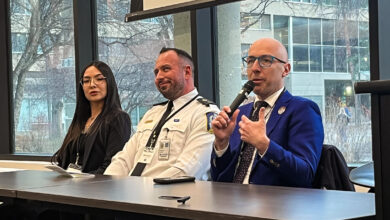 Leah Hennig
Leah HennigThe Baker Lab at the University of Alberta has found that DNA repeats observed in certain colorectal cancer cells may be the key to making resistant cases treatable.
The study was led by Shayla Mosley, a PhD candidate in oncology. During her undergraduate studies in molecular genetics, also at the U of A, she discovered her love for research and met her supervisor Kristi Baker at an open house.
Baker, an associate professor in the departments of oncology and medical microbiology and immunology, has been studying colorectal cancer since she was a PhD student at McGill University. It’s a topic she has personal interest in, she explained, as her grandmother died of colon cancer.
She went on to complete her postdoctoral research in intestinal immunology at Harvard Medical School. Now in her lab at the U of A, she combines her expertise in these two fields to study the immune responses associated with different types of colorectal cancer.
“There’s a very small proportion of colorectal cancers that do respond really well [to immunotherapies] and have really good anti-tumor immune responses … so we wanted to try and understand what was different about those few cases … in the hope that we could use that knowledge to improve the prognosis and immunotherapy response of the rest of colorectal cancer patients,” Mosley explained.
The addition of certain DNA structures can improve existing cancer treatments, U of A researchers find
According to the study, colorectal cancers that have unstable DNA repeats or “microsatellite instability” are better at triggering an anti-tumor immune response than colorectal cancers that do not have this feature.
This happens through the cGAS-STING pathway. As Mosley explained, cyclic GMP-AMP synthase (cGAS) binds to the repeats, activating stimulator of interferon genes (STING). This ultimately activates T cells, immune cells that can recognize and kill cancer cell by cell. This is what makes colorectal cancers of this type susceptible to immunotherapy.
To help them make this discovery, the lab used 3D organoids — “mini-colon[s],” Mosley described — made from donated human tumor samples, in addition to the traditional methods of animal models and cell cultures.
Since each colorectal cancer tumor is different, “cell cultures … don’t really reflect the diversity that you see in [colorectal] cancer as a disease,” Baker explained.
Additionally, to observe the interactions between cancer cells and immune cells, “you can’t just take cancer cells from one person and immune cells from another person and put them together” for the same reason organ donors need to be matched to transplant recipients, Baker added.
As such, they created a system where they could observe cancer cells and immune cells from the same person.
Baker credits the patients who have provided tissue samples to support her lab’s research and her trainees “who do all of this hard work.”
Baker Lab aims to advance colorectal cancer research
Currently, Baker’s team is focused on creating a structure that will activate the cGAS-STING pathway in the majority of colorectal cancers that are immunotherapy resistant.
They’re using atomic force microscopy to look at the three dimensional structures these DNA repeats make as changes to this structure may affect how well the DNA activates the cGAS-STING pathway.
When asked about roadblocks they foresee in making this structure, two came to mind.
“We have to be careful that we’re designing a DNA structure/sequence that activates STING in a beneficial manner,” Mosley explained.
While STING can induce anti-tumor immune responses in certain cases, it can also induce pro-tumor effects in others, and currently, “it’s not really understood how STING is induced to act in these different ways,” Mosley said.
“That’s something we’re looking into quite extensively at the moment.”
The other is delivery: to get the DNA structures not just into the tumor, but into anti-tumor immune cells while minimizing side effects.
“That’s one of the major roadblocks with the implementation of all immunotherapies,” Baker explained. “If we just give these DNA molecules systemically to the patient, we’re going to activate immune responses that we don’t want elsewhere in the body.”
Baker is interested in better understanding what happens when you promote or inhibit STING activation in these diseases.
This not only has consequences for our understanding of these other diseases, but also for our ability to “combat … side effects for current immunotherapies,” she explained.




